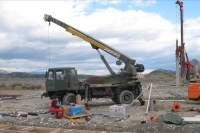Hydro Power Plant Ashta, Drin River, Albania
Client: PORR AG
Development Period: since 10/2009
In the North of Albania, a run-of-river power plant is to be built in the vicinity of the village of Ashta as the last of four power plants at the Drin River. The company Energji Ashta Sh.p.k has been commissioned with the construction and operation for 35 years. The Austrian companies Verbund AG and EVN AG (energy supply Lower Austria) each hold 50% of this contractor. Subsequently, the PORR AG was put in charge of the construction.
The project takes advantage of an existing weir system, which has been established for the purpose of irrigation. It basically comprises the modification of the weirs, the construction of two power houses and of a connecting canal as well as earth works and sealing works by means of thin diaphragm walls.
For this project, BGG Consult has been commissioned by PORR AG with consulting in the fields of geotechnics and hydrogeology already during the tendering phase. For this, the existing results of exploration works and documents were evaluated. Based on these, a geotechnical statement with proposals regarding the dewatering and construction pit securing measures has been compiled in cooperation with GEOTECHNIK ADAM ZT-GmbH.
After the assignment of PORR AG, supplementary subsoil exploration works were planned and supervised.
During construction, the details of the construction pit securing and dewatering measures are worked out, and further geotechnical and hydrogeological questions dealt with.
Dewatering of the Construction Pits:
Already in the tendering phase, BGG Consult established, that the exploration works were insufficient for the construction and that an adequate evaluation of the dewatering measures given in the tender documents was not possible based on the existing data.
Because of the results of the subsequent subsoil investigations and hydraulic tests, the originally planned construction concept had to be discarded due to the expected high pumping rates. Instead, the bottom plates of the structures were established below the water table.
The professional assessment and supervision during the tendering and realization phase saved the construction company and the concessionaire a considerable amount of time and expenses.
April 2011
